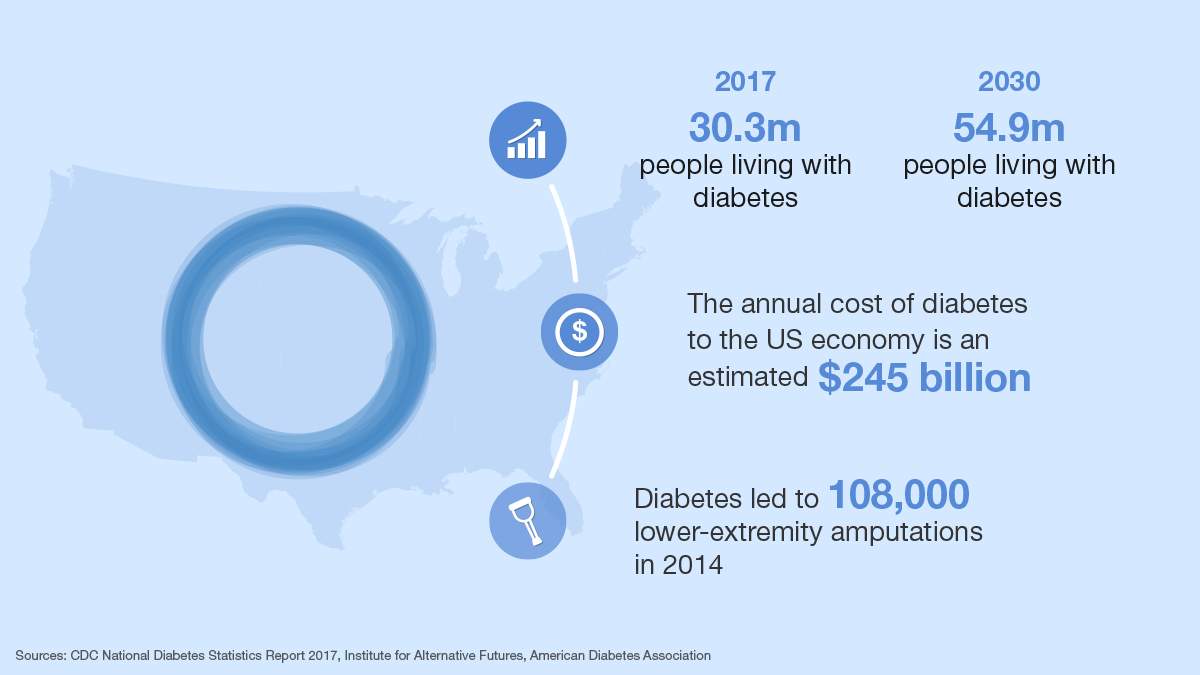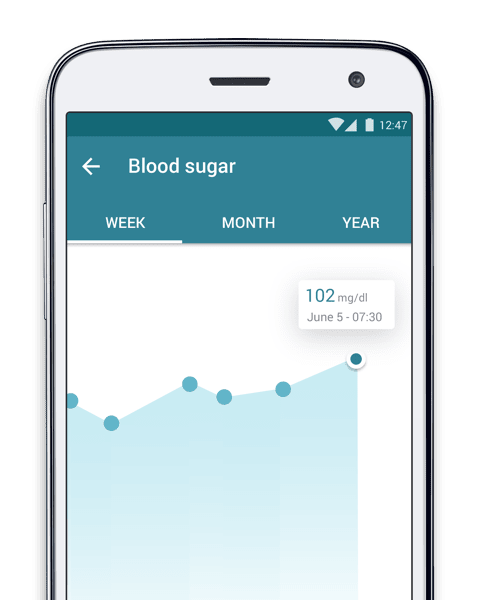The cost of diabetes, on both a financial and human level, is enormous. It affects the lives of millions of people in the USA, at the cost of billions of dollars, and leads to hundreds of amputations each and every day. These startling statistics are predicted to rise in the coming years and decades. In this article we explain the impact of both type 1 and type 2 diabetes, the human and financial cost, and a look at what the future hold.
The Role of Insulin in the Human Body
Every one of the 37.2 trillion cells in the human body requires energy, which they most commonly get by taking glucose, a simple sugar, from the blood stream. Cells can also store glucose as glycogen for a steady supply of energy that is readily available. However, glucose needs a helping hand in entering the cells, and insulin is the key that unlocks the gate. When high glucose levels are detected in the blood stream – after a meal, for instance – the pancreas releases insulin. Insulin attaches to cells’ insulin receptors, triggering a series of events that results in glucose finding its way into cells.
It is an important process, as too much glucose in the blood stream is toxic, and can damage vessels that supply blood to vital organs. High blood sugar, technically called hyperglycemia, is a risk factor for heart disease, stroke, kidney disease, and vision and nerve problems.
What Happens in Those Living with Diabetes
To understand how diabetes affects the process, it is important to differentiate between type 1 and type 2 diabetes. While the symptoms may be similar, the two forms of diabetes fundamentally differ.
Type 1 diabetes is usually diagnosed at a young age, often during childhood, although it can occur at any age. It is characterized by the body destroying the cells that produce insulin in the pancreas. With no insulin, the body is thus unable to transfer glucose from the blood stream into cells. If left untreated, blood sugar levels increase, resulting in hyperglycemia and the subsequent risks it entails. Prior to the aforementioned work of Sir Banting and co., a diabetes diagnosis was essentially a death sentence, with people usually surviving for between six months and four years. Thankfully, it can now be controlled with insulin injections, a careful diet, and exercise.
Type 2 diabetes tends to occur later in life, and is far more common than type 1, accounting for around 90% of all cases of diabetes in the USA. It is characterized by the body making an insufficient amount of insulin, or the insulin receptors of cells becoming desensitized. In those living with type 2 diabetes, the body is simply unable to utilize the insulin it produces. It is more likely to be treated with medication, often with the aim of increasing the sensitivity of insulin receptors, although insulin injections are also sometimes required.
A third type of diabetes is gestational diabetes. It occurs in pregnant women, and is caused by the body being unable to meet the additional insulin required during pregnancy. It can be treated with medication or insulin injections. While it usually goes away after birth, women who experience it are at an increased risk of developing type 2 diabetes in the future.
The Cost of Diabetes in the USA
As the above infographic shows, diabetes is an extremely serious health issue in the USA, affecting over 30 million people, or 9.4% of the population. An estimated 7.2 million of those are undiagnosed. On top of that, an estimated 84.1 million adults in the USA had prediabetes in 2015, meaning their blood sugar levels are higher than normal, and the risk of diabetes is increased.
In the same year, nearly 80,000 deaths listed diabetes as the underlying cause, and over a quarter of a million in total listed it as an underlying cause or contributing factor. That makes diabetes the 7th leading cause of death in the USA.
The $245 billion figure in the infographic is the cost diabetes has on the US economy; the figure rises to a staggering $322 billion when the cost of prediabetes is factored in.
A significant portion of this money was spent on diabetes-related lower-extremity (below the hip) amputation procedures, of which there were 108,000 in 2014.
These figures demonstrate the cost diabetes has on the country, in terms of both life and money.
Why Does Diabetes Lead to Amputations?
An amputation is one of the most serious and life-threatening potential consequences of diabetes, and carries with it significant short and long-term risks.
A combination of factors put those living with diabetes at risk of requiring an amputation procedure. Diabetes – whether type 1 or type 2 – is a key risk factor for peripheral artery disease (PAD), which impedes blood flow to the limbs. This impacts the skin and its ability to heal, as cells cannot get the oxygen and nutrients needed. As well as that, one of the most common symptoms of diabetes is nerve damage, often affecting the legs and feet first, which can prevent pain signals reaching the brain.
Therefore, people with diabetes might not notice blisters or other foot wounds and continue to walk on them. This, combined with the body’s reduced healing capabilities, can very quickly lead to a foot ulcer. An untreated foot ulcer can lead to infection and gangrene, which can then result in the need for an amputation
Around 15% of people with diabetes will have a foot ulcer at some point, and around 24% of those will need an amputation.
This is the reason diabetes is a leading cause of amputations, primarily of toes, part of the foot, or lower leg. Around 67% of all limb amputations in the USA can be attributed to diabetes. Worldwide, a leg is lost every 30 seconds.
Alarming though these statistics are, the good news is that simple steps can go a long way in preventing foot ulcers. Recommendations include keeping feet clean, checking them daily, keeping toenails clipped, avoiding walking barefoot, and wearing shoes that fit well. Any corns, callouses, or wounds that appear should be immediately treated by a podiatrist. On top of that, at least one professional check-up should be performed annually.
Former American Podiatric Medical Association (APMA) President, Frank Spinosa, said in 2014 that including a podiatrist in diabetes care can reduce the rate of amputations by up to 85%. The average cost of an amputation exceeds $70,000, and it is estimated that for every $1 invested in podiatric care, between $27 and $51 is saved in healthcare. Preventing amputations will therefore not only save lives, but help reduce the huge amount of money diabetes costs the economy, healthcare system, and those living with diabetes.
Prevention and Detection
The Institute for Alternative Futures (IAF) estimates that if recent trends continue, the number of people with diabetes in the USA will almost double by 2030, reaching nearly 55 million adults.
Such an alarming prediction highlights why initiatives such as World Diabetes Day are so important, as greater awareness can help ensure such a prediction never comes to fruition. The Center for Disease Control and Prevention (CDC) established the National Diabetes Prevention Program (National DPP) for much the same reason, offering people the tools to protect themselves from developing type 2 diabetes by making a few healthy lifestyle changes. The year-long course specifically aims to help people with prediabetes, and those at risk of developing diabetes, embrace new habits and skills that will help them protect themselves from developing diabetes.
Many of the lifestyle changes they encourage revolve around improving diet, increasing exercise, sleeping well, and replacing sugary drinks with water. Such changes decrease the possibility of obesity, which is a key risk factor for type 2 diabetes.
For those who have already developed type 2 diabetes, all is not lost. Being aware of the condition is the first step in overcoming it, which is why the number of undiagnosed cases is particularly concerning. The IAF predict the number of people with diabetes but are undiagnosed will drop from 27% to 24% which, while an improvement, will still mean millions of people are unaware of their condition. This is important, as a diagnosis can be a catalyst for many people to make the lifestyle changes mentioned, which can be extremely effective in limiting and reversing the effects of type 2 diabetes, even after a diagnosis. Smoking, for example, severely prohibits blood flow, and quitting can help improve circulation and reduce the risk of foot ulcers that could lead to an amputation, while exercise helps the process of glucose entering cells.
Detection is also crucial in managing type 1 diabetes. Awareness is again key, particularly for parents whose children may be living with the condition. Frequent urination, excessive thirst, increased appetite, unexplained weight loss, and tiredness are all possible symptoms of type 1 diabetes. Likewise, if they complain of blurred or impaired vision, or their breath smells sweet. The sooner such symptoms are recognized, the sooner a simple blood test can confirm whether or not diabetes is the cause. If it does prove to be diabetes, an early diagnosis makes treating it that much easier and effective.
What Does the Future Hold?
While the figures predicted by the IAF are startling, they are by no means guaranteed. Awareness, education, and support are paramount in helping the population of the USA recognize the symptoms of both type 1 and type 2 diabetes, and take the necessary measures to control them.
For those living with prediabetes, early detection can prove a catalyst for healthy lifestyle changes.
For those with type 2 diabetes, healthy lifestyle changes, regular check-ups, and adherence to medication can help reduce and reverse symptoms.
For those living with type 1 diabetes, early detection can mean effective, long-term treatment.
The more people who take these measures, the more effective the nation becomes in stemming the increase of diabetes, and its subsequent health issues. In the long-run, such measures can save thousands of lives, and billions of dollars.
Are You at Risk of Prediabetes or Type 2 Diabetes?
Some of the risk factors for prediabetes are:
- Being overweight
- Being over 45
- Having a high sugar and red meat diet
- Doing little exercise
- Having a family history of diabetes
- Sleeping too little
- Being of African American, Hispanic, Native-American, Asian-American, or Pacific Island descent
If you think you may have prediabetes, speak to your doctor about a blood glucose screening.
Symptoms of type 1 and type 2 diabetes include:
- High levels of thirst and hunger
- Weight loss
- Blurred vision
- Frequent urination
- Fatigue
If you think you or a loved one may have diabetes, immediately seek medical assistance.
How Can World Diabetes Day Help?
On November 14th, 1891, Nobel Prize winner, Sir Frederick Banting, was born in Ontario, Canada. In the early 1920s, he and his assistant, Dr Charles Best, were the first people to use insulin therapeutically. Their successful treatment of 14-year-old, Leonard Thompson, who lived with type 1 diabetes, paved the way for modern diabetes treatment. Nearly a century on from that very first insulin injection, Sir Banting’s birthday is the date for World Diabetes Day. Since its inception in 1991, World Diabetes Day has campaigned to raise global diabetes awareness, and more than 230 International Diabetes Federation (IDF) national associations now contribute to the campaign. With diabetes prevalence continuing to rise in the USA, it is as important as ever to raise diabetes awareness, and give people across the country the tools to help tackle the rising costs.
If you like this post, you may also like:



